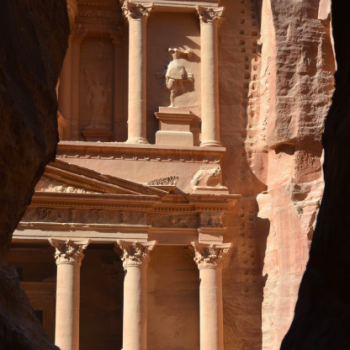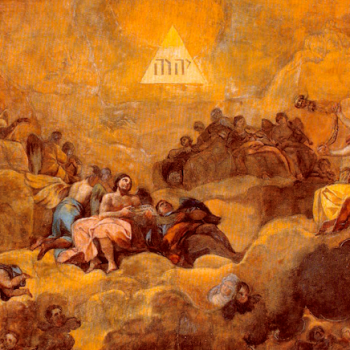Go here for an introduction to the rosary.
The Mysteries
The Joyful Mysteries revolve around the Incarnation. They are as follows (with Scriptural sources linked):
1. The Annunciation to the Virgin by Gabriel
This covers Gabriel’s appearance to Mary, his prophecy of Christ’s mission, and her final assent to the Incarnation.
2. The Visitation of the Virgin to Elizabeth
This covers Mary’s joining Elizabeth and Zacharias (the parents of John the Baptist) at their home in Judea, the unborn Baptist leaping for joy at their arrival, and the recitation of the Magnificat.
3. The Nativity of Christ at Bethlehem
This covers Christ’s birth, the appearance of the angels to the shepherds, and their adoration of the Child.
4. The Presentation of Christ in the Temple
This covers the sacrifice offered by Joseph to redeem Christ as Mary’s firstborn, Simeon’s recognition of Christ as the messiah, and his prophecy to Mary.
5. The Finding of Christ in Jerusalem
This covers Joseph and Mary searching for Christ after he was lost during Passover, their discovery of him in the Temple, and the wisdom he spoke to the elders and to his parents.
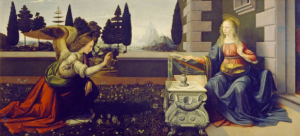
Before we get into Scriptural meditations, though, we need to take a quick detour to talk about the different meanings Scripture can have.
Fourfold Meaning
From the earliest centuries of Christian theology, the Bible has been interpreted in multiple senses. This probably goes all the way back to Christ (e.g. “Destroy this temple, and in three days I shall raise it up,” making the temple itself a figurative expression for his body), and certainly goes all the way back to the authors of the New Testament, particularly St. Paul; his free allegorization of both sacred history and the Law make it clear that this was a normal form of interpretation and preaching in the primitive Church.
By about the third century, Christians conventionally ascribed four specific levels of meaning to Scripture:
- the literal, i.e. what it means as literature1
- the allegorical, i.e. how the literal sense figuratively applies to Christ’s life and work on earth
- the moral, i.e. how it figuratively applies to the operation of grace, conversion, and virtue in the soul
- the mystical or anagogical,2 i.e. how it figuratively applies to the final union of the soul with God
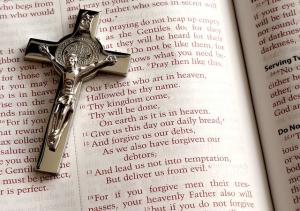
Dante famously used the opening verses of Psalm 114 in a letter to illustrate these four meanings. The text reads, “When Israel came out of Egypt: and the house of Jacob from among the strange people, Judah was his sanctuary: and Israel his dominion.” In the literal sense, this of course refers to the Exodus. Allegorically, it refers to Christ’s redemptive work in the Resurrection (cf. Luke 9.31, where the word decease is, in Greek, εξοδος or “departure”). Morally, it refers to the conversion of the soul from a state of sin to a state of grace; mystically, to the consummation that awaits us after the Second Coming.
Okay; so what does any of this have to do with the rosary?
Meditations for the Joyful Mysteries
Simple. Once we’ve remembered (or looked up) what each mystery is, reflecting on Scriptures that are literally about that mystery is just one use we can make of Scripture. We can also look for texts that apply to these mysteries allegorically, morally, or mystically. This helps us enrich both our grasp of Scripture, and our grasp of the mysteries themselves.
My go-to meditations for the Joyful Mysteries, therefore, usually come either from Old Testament history and legend or from wisdom literature, even though the Gospels literally describe these events. Do remember, these are just examples—by all means look for other options.
Historical Meditations
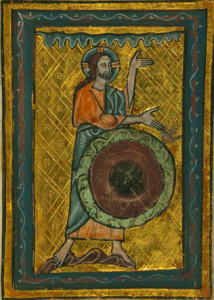
1. The Annunciation. Genesis 1.3, The Spirit of God moved upon the face of the waters. Cf. Luke 1.35, The Holy Ghost shall come upon thee, and the power of the Highest shall overshadow thee; note also that Miriam, the Hebrew name from which Mary is derived, means “ocean, bitter sea.”
2. The Visitation. II Samuel 6.9, How shall the ark of the Lord come to me? Cf. Luke 1.43, And whence is this to me, that the mother of my Lord should come to me? II Samuel 6.2-12 has long been compared and contrasted with the Visitation, largely because the Ark of the Covenant (in which a portion of manna was hidden) is often allegorically understood as a prefiguration of the Blessed Virgin.
3. The Nativity. Genesis 1.27, So God created man in his own image. Cf. Colossians 1.15, 19, Who is the image of the invisible God, the firstborn of every creature … For it pleased the Father that in him should all fullness dwell. The image and the thing it images (in technical language, the ectype and its archetype) are in Christ wholly united.
4. The Presentation. Genesis 12.3, I will bless them that bless thee, and curse him that curseth thee: and in thee shall all families of the earth be blessed. Cf. Luke 2.34-45, Behold, this child is set for the fall and rising again of many in Israel; and for a sign which shall be spoken against; (yea, a sword shall pierce through thy own soul also,) that the thoughts of many hearts may be revealed.
5. The Finding. Psalm 73.15-16, Then I thought to understand this: but it was too hard for me, until I went into the sanctuary of God. Cf. Luke 2.48, Son, why hast thou thus dealt with us? behold, thy father and I have sought thee sorrowing. The problem that had distressed the psalmist was why the wicked flourish while the righteous are oppressed.
Wisdom Meditations
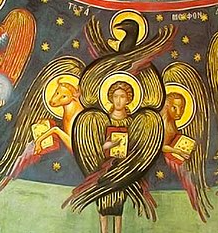
1. The Annunciation. Wisdom 7.7, I prayed, and understanding was given me: I called upon God, and the spirit of wisdom came to me. Compare this with the Virgin’s bold and careful testing of St. Gabriel in Luke 1.34, to determine whether he was an angel of the Lord or a spirit of temptation.
2. The Visitation. Sirach 24.1, Wisdom shall praise herself, and shall glory in the midst of her people. One of the Blessed Virgin’s titles is “seat of wisdom” (think of her holding the Christ child in her lap, as if she were his throne), and this text pairs easily with the Magnificat.
3. The Nativity. Sirach 24.8, So the Creator of all things gave me a commandment, and he that made me caused my tabernacle to rest, and said, Let thy dwelling be in Jacob, and thine inheritance in Israel. Cf. John 1.14, And the Word was made flesh, and dwelt among us, and we beheld his glory; the Gospel of John draws on the imagery of Hebrew literature about divine wisdom in its description of the Word, and the verb translated “dwelt” here is related to the word for “tabernacle.”
4. The Presentation. Sirach 24.32, I will yet make doctrine to shine as the morning, and will send forth her light afar off. Cf. Luke 2.32, A light to lighten the Gentiles, and the glory of thy people Israel.
5. The Finding. Deuteronomy 4.7, For what nation is there so great, who hath God so nigh unto them, as the Lord our God is in all things that we call upon him for? Cf. the exchanges between Christ and the elders in Luke 2.46-47.
Footnotes
1This term can get a little confusing when the type of literature in question is heavily symbolic, as in apocalyptic books like Daniel or Revelation, or in books that are essentially historical novels, like Judith. The thing to keep hold of is that literal, in this context, means “of or pertaining to literature”; literary might be a usable alternative. The in-this-sense literal meaning of a phrase like “my heart is broken” is “I am in great sorrow and pain,” not “there is a fissure in my cardiac muscle”; flat-footedness has nothing to do with literary meaning. Thus, the literal meaning of a text can be metaphorical or symbolic; it is the thing the metaphors or symbols are about that has the additional three meanings.
2In the name of making everything more confusing, the terms allegorical and mystical are sometimes used collectively to refer to all three kinds of non-literal interpretation. (However, when the word anagogical is used, it only ever means the fourth kind.)



